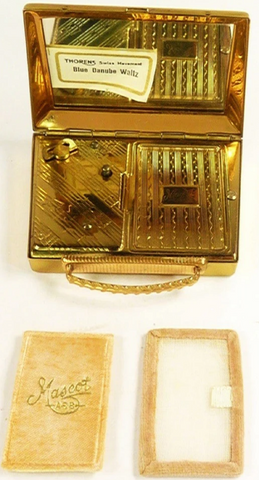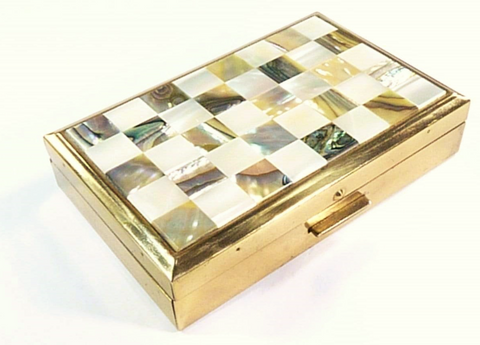
All About Antique Music Boxes, Musical Powder Boxes & Reuge Music Boxes

The most coveted music boxes are those that feature singing birds. Boîte à oiseau chanteur are usually ornately decorated and just below an oval lid is an exquisitely beautiful automaton singing bird which is activated when the lever is triggered.
It may seem a little strange when we think of what makes the 1960s famous, that Reuge decided to concentrate on reviving the singing bird music boxes. They took over the manufacture and marketing of mechanical singing birds of the Parisian company Bontems in 1960 and also Eschle in 1977. Not only this but they developed many new tunes to keep one step ahead of their rivals.
In 1988 Guido decided to sell the company, as he had no direct descendants. A group of Swiss investors purchased the firm. Further expansion followed and in 2001 Reuge purchased the company who had been its main supplier of wooden boxes. This ensured that the whole manufacturing process was now 'in house'. Today Reuge is the largest employer in Sainte-Croix.
A simple Reuge music box takes about three months to produce. Obviously, the more ornamental and complex designs take much longer to manufacture and adorn.
The artisans employed by this firm transform the score into a tune. They are experts in both musical and technological matters.
THE PROCESS OF PINNING
© Reuge
A machine drills tiny holes in the cylinder. Next pinning (see above) takes place….. needle-thin steel wire is inserted into each hole. It is then cut to form a pin.
DRILL BITS CUT THE TEETH OF THE COMBS
© Reuge
These techniques were pioneered by Reuge. The next process is known as hardening. The comb is heated to nearly 800°C - it is plunged into a bath of warm oil. The comb’s extreme hardness is then refined and managed by tempering. It has to be durable and not brittle - rigid and not too flexible. All these stages ensure the incomparable sound quality which has made this brand sought-after all over the world.
Lead is then poured under the comb teeth for the bass notes. This technique makes sure that the notes are clear. The lead is sawn by hand to create the teeth. Then the music box is tuned. Each tooth has to be filed to make the correct note.
Musical movements are assembled by hand. The cylinder, spring-housing, speed governor, trigger and tune indicator are assembled together on the base-plate. Then fixing the comb is the final and most difficult operation. It requires a craftsman who can create the perfect sound using his experience and musical talent.
MUSIC MACHINE 3
© Reuge
Today the firm goes from strength to strength. It is highly regarded and innovative. For example, the futuristic The Music Machine 3 – was created in partnership with watch atelier MB&F.
It plays the theme tunes from Star Wars, Mission Impossible and James Bond.
THE REUGE WATCH
© Reuge
The Reuge Watch measures 2 1/2" (6 cm). The image shows this delightful creation on the original stand with the winding key. An animated scene shows a lady pumping water from a well for a horse. The horse is drinking, and the man astride the horse is trying to keep hold of a newly caught falcon that is trying to fly free. The watch contains 2 mechanisms: a mechanical watch movement and a tiny 17-note musical movement. An alarm is incorporated to start the music at a certain time.
The pastoral scene was designed by the enameller Carlo Poluzzi after a painting by Lancret, and the design on the rear was inspired by a Moreau engraving. There is a Breguet-style ratchet winding key in the form of a lyre.

In the 1940s allied troops purchased music boxes in Europe to take home as tokens of love. The music boxes fitted with Swiss musical movements were so enchanting and reliable that musical boxes from Switzerland were very much in demand. This trend did not go unnoticed by the makers of the Stratton brand who were known as Jarrett, Rainsford & Laughton Ltd., until 1958 when the firm was renamed Laughton & Sons Ltd. This company became regular customers of Reuge and Thorens, purchasing their high quality musical movements for their beautiful enamel ‘‘Musicas’ which became known as ‘Musical’ in 1964.
Reuge musical movements were considered superior and more reliable than their rivals. The company also had a larger repertoire of tunes. Only the best would do for the Stratton brand. Seventy years later the Stratton 'Musica' and 'Musical' powder boxes are still playing reliably well and looking splendid.
The most coveted of the Stratton musical powder boxes are those adorned with ballet scenes which were often taken from Stirling Henry Nahum's photographs. He was also known as Sterling Henry Nahum. He used the name Baron to sign his photographs, as this was his professional name. His most notable work was as a society and court photographer in the United Kingdom. He had a special interest in photographing ballet dancers.
1957 was the first known year of availability for the Stratton 'Musica'. The series was part of the luxury range of Stratton vanities. The body of the powder box resembles the 'Empress' and the 'Grosvenor'. All ‘Musica’ and the later model ‘Musical’ powder boxes are considered uncommon to rare, depending on the lid decoration.

The image above shows an unused Lucite Stratton 'Musica' which has all the original accessories - presentation box, pouch, box sticker, instruction leaflet, puff and sifter. The lid is a beautiful design of musical notes with facet cut rhinestones set atop Lucite.

1950S STRATTON MUSICAL POWDER BOX
All musical boxes are different. Some may require three full turns in a clockwise direction to play the whole tune. Others may only allow two quarter turns before you feel as though the winding key is becoming a little resistant. Always cease winding if you feel any resistance. We become familiar with our adorable little music boxes. While they live with us they will be played once a month and oiled if necessary. When we have found a new home for one of them we make sure to ship the piece with its own winding instructions so that the new owner will know how to wind the music box.
Here are some tips for keeping your musical powder box in good working order:
- 1. It is important not to over-wind your musical powder box.
- 2. Turn the winding key in an anti-clockwise direction.
- 3. Always let your music box play the tune fully.
- 4. Do not store the vintage music box with the tune still to play. It is bad for the mechanism.
- 5. Never ship the music box still with the tune to play, as the recipient may well turn the key on receiving the musical box not knowing that the sender left it fully wound. This is why many are over-wound.
- 6. Face powder may clog the musical movement and prevent it from playing. The powder should be removed and the movement oiled. This will often restore the movement to playing mode again.
- 7. Let your music boxes play at least once a month.
- 8. Many of the Stratton 'Musicas' have a press stud to close the pouch. It is not a good idea to push on the metal press stud to close it when there is an enamel lid below the press stud. Later on Laughton & Sons Ltd. introduced Velcro tapes to replace the press studs.
How to play your musical powder box:
- 1. Lift up the stopper to see if the music box is wound. This is so important, as if you wind an already wound music box you might over wind it and break it. The stopper is a tiny button which will stop the music from playing. It is located in the inner case near to the winding key.
- 2. If the music does not play, gingerly test the winding key. Is it stiff? If it is not stiff and there isn't any resistance, turn the winding key one full turn if this is possible and let the music play.
- 3. If the winding key is stiff do not force it. The mechanism may be jammed by powder. Inspect the mechanism, brush away all the powder and spray the mechanism with WD40. Then try lifting the stopper again.
- 4. On closing the powder box the lid will push the stopper down which will stop the music from playing.
- 5. Sometimes musical powder boxes need a slight jolt before playing if after following the above steps it does not play, ping open the inner lid & the music may start. If this is the case the music box probably needs some lubrication with WD40.


An adorable working 1950s Kigu Minuette music box which is fitted with a lovely Perspex (Lucite) shamrock decoration. The original pouch, puff and sifter are present.
The inner case is signed KIGU and also Minuette. The base is also signed KIGU MADE IN ENGLAND REG.DES. The base has a lovely scalloped design. The whole musical powder box is protected by the Kigu jeweller's gilt finish which will prevent tarnishing and so this vanity will not require any cleaning. The catches and hinges work perfectly. Measures 8.5 cm long. Weighs 129 grams.
Kigu Ltd. describe this lovely vanity as:
Musical Compacts "Minuette" Series
fitted with excellent Swiss movement
Great variety of tunes
73-763 Musical "Minuette" compact with coloured Perspex insert
in gilt E.T. (engine turned) pattern




A brief history of Sankyo:
NIDEC SANKYO has dominated Japan's history of musical movement production for more than half a century. In the far east the Japanese firm was busy perfecting its musical movements in the 1940s. Today we can hear them play in our mid-century Clover brand music boxes.

CLOVER MOP & ABALONE MUSIC BOX
© Sankyo
In 1946 Sankyo Seiki was established in Suwa. The firm is now known as the Nidec Sankyo Corporation. Within two years the first sets of music boxes were being produced as experiments to test their durability. The first six sets unfortunately had 'teeth' that broke. There were other musical movements that were more durable but the sound quality was not good enough. By the end of 1948 Sankyo were pleased enough with their products to fulfil an order for 500 music boxes. At one time Sankyo is said to have produced 90% of musical boxes in the world.
SMALL BEGINNINGS - THE SANKYO FOUNDING OFFICE 1946
© Sankyo
MUSIC BOXES IN DAILY LIFE
© Sankyo

SANKYO HEAD OFFICE & LAKE SUWA
© Sankyo
American brands such as Volupte also made splendid music boxes.

Sources:
http://keithwright.ca/Thorens/Schuco/Schucopage.html
The link below will take you to an illustrated timeline for Reuge music boxes:
https://www.frontgate.com/wcsstore/images/Frontgate/moreinfo/Reuge.html
https://www.reuge.com/the-ateliers/history/